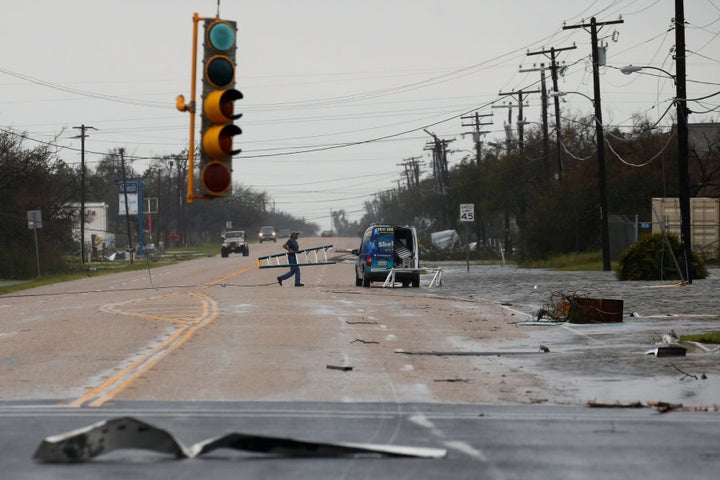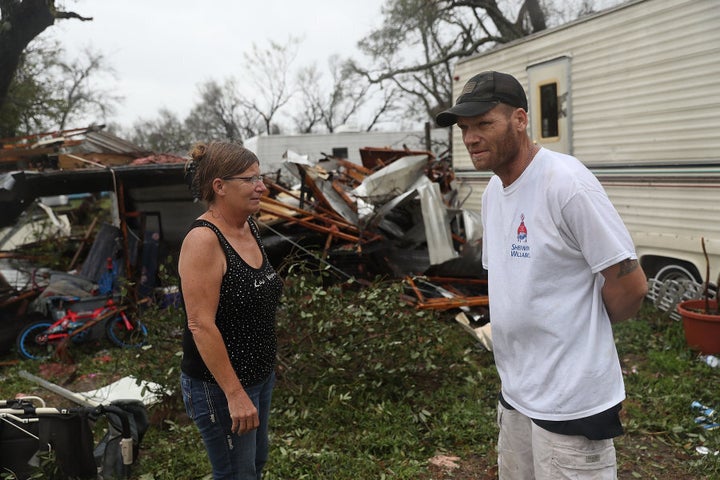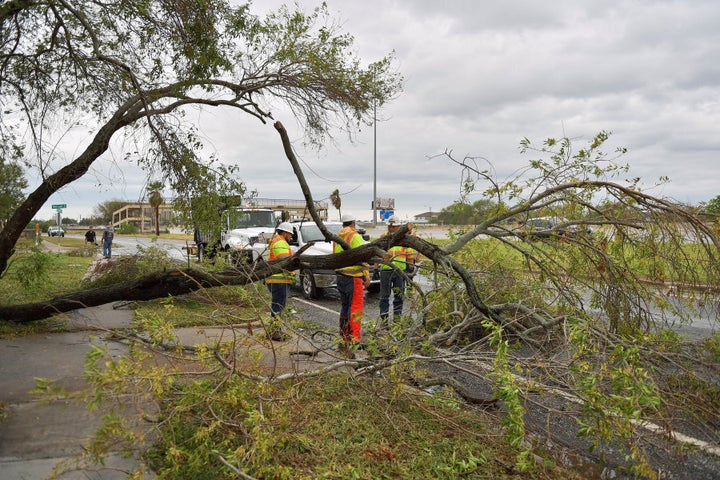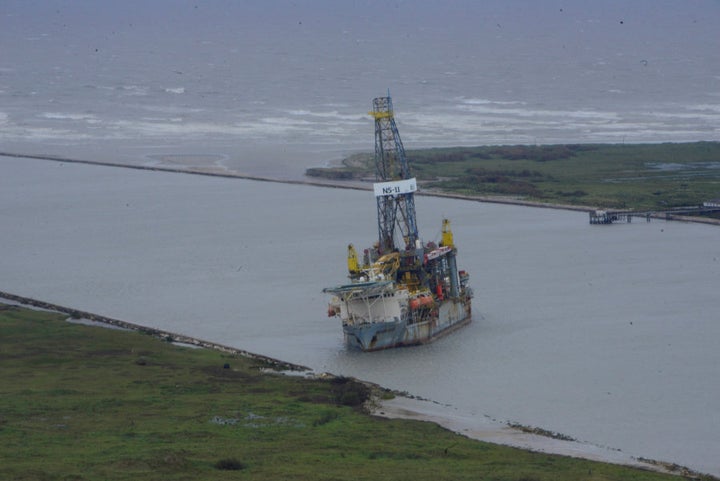ROCKPORT, Texas, Aug 27 (Reuters) -- A second person was killed on Saturday as Harvey, the most powerful storm to hit Texas in more than 50 years, roared inland, knocking out power to more than 200,000 people and threatening catastrophic flooding.
The second fatality was an elderly woman who was killed as she drove through flooded streets on Houston's west side on Saturday night, a Houston police officer said.
"It appeared that her vehicle went into high water and she drowned as a result," said Sergeant Colin Howard of the Houston police department. The victim was not immediately identified.
Authorities have urged residents to stay off the streets of Houston and other southeast Texas cities as rain falling at up to 5 inches per hour flooded roads and major intersections.
On Friday night, a man died in a house fire in the town of Rockport, 30 miles (48 km) north of Corpus Christi. Another dozen people in the area suffered injuries like broken bones, another official said.

Harvey slammed into Texas late Friday as a Category 4 hurricane with winds of 130 miles per hour (209 km per hour), making it the strongest storm to hit the state since 1961.
It has since lingered over Houston, dumping amounts of rain that threaten to break the record established nearly 40 years ago when Alvin, Texas, was deluged by 43 inches of rain in 24 hours from July 24-25, 1979.
The storm ripped off roofs, snapped trees, triggered tornadoes and flash floods and cut off power to nearly 230,000 people, mostly in the Houston area, on Saturday night. Houston police officials said officers were evacuating two flooded apartment complexes.
The National Weather Service issued a flash flood emergency alert for the area around William P. Hobby Airport, and the airport said on Twitter that the arrivals section was flooded.
Oil and gas production was largely halted in the state, prompting price hikes at the pumps.

"There are a number of stranded people on our streets, calling 911, exhausting needed resources. You can help by staying off the streets," Houston Mayor Sylvester Turner said on Twitter.
'IT WAS TERRIBLE'
Harvey was downgraded to a tropical storm on Saturday but was expected to lash Texas for days as it lumbers inland, according to the National Hurricane Center, which described the forecast for the state as potentially "catastrophic."
Rockport, which took a direct hit from the storm, was left with streets flooded and strewn with power lines and debris on Saturday.
A dozen recreational vehicles were flipped over on a sales lot, one blown into the middle of the street. A convoy of military vehicles arrived in the Rockport area on Saturday to help in the recovery efforts, and town officials announced an overnight curfew for residents.
"It was terrible," resident Joel Valdez, 57, told Reuters. The storm ripped part of the roof from his trailer home at around 4 am, he said as he sat in a Jeep with windows smashed by the storm. "I could feel the whole house move."
Before the storm hit, Rockport's mayor told anyone staying behind to write their names on their arms for identification in case of death or injury. A high school, hotel, senior housing complex and other buildings suffered structural damage, according to emergency officials and local media.

Texas Governor Greg Abbott said he was activating 1,800 members of the military to help with the statewide cleanup, while 1,000 people would conduct search-and-rescue operations.
The streets of Corpus Christi, a city of about 320,000 people, were deserted on Saturday, with billboards twisted and strong winds still blowing. City authorities asked residents to reduce use of toilets and faucets because power outages left waste water plants unable to treat sewage.
Elsewhere, the Texas Department of Criminal Justice said it was forced to evacuate some 4,500 inmates from three state prisons near the Brazos River because of rising water.
20 RESCUED AT SEA
The U.S. Coast Guard said it had rescued 20 people from distressed vessels on Saturday, and was monitoring two Carnival Corp cruise ships carrying thousands of people stranded in the U.S. Gulf of Mexico.
Harvey was a Category 4 hurricane on the Saffir-Simpson scale when it hit the coast, the second-highest category, and the most powerful storm in over a decade to come ashore anywhere in the mainland United States.

It weakened to tropical storm from hurricane strength on Saturday, the U.S. National Hurricane Center said.
Authorities warned of the potentially life-threatening impact of heavy rains between Houston and Corpus Christi over the next several days, with the latest forecast storm track forecasting that Harvey could loop back toward the Gulf of Mexico coast before turning north again on Tuesday.
"This rain will lead to a prolonged, dangerous, and potentially catastrophic flooding event well into next week," the National Weather Service said.
The size and strength of Harvey dredged up memories of Katrina, the 2005 hurricane that made a direct hit on New Orleans as a Category 3 storm, causing levees and flood walls to fail in dozens of places. About 1,800 died in the disaster made worse by a slow government emergency response.
U.S. President Donald Trump, facing the first big natural disaster of his term, signed a disaster proclamation on Friday. He met with his cabinet and staff on Saturday to discuss the federal reaction to the storm, according to a White House statement.
"President Trump emphasized his expectations that all departments and agencies stay fully engaged and positioned to support his number one priority of saving lives," according to the statement.
Several refiners shut down plants ahead of the storm, disrupting supplies and pushing prices higher. Many fuel stations ran out of gasoline before the storm hit, and the U.S. Environmental Protection Agency loosened gasoline specifications to reduce shortages.
Disruptions to fuel supply drove benchmark gasoline futures to their highest price in four months.
More than 45 percent of the country's refining capacity is along the U.S. Gulf Coast, and nearly a fifth of the nation's crude is produced offshore in the Gulf of Mexico.
Just under 25 percent of Gulf output, or 429,000 barrels per day (bpd) had been shut in by the storm, the U.S. Bureau of Safety and Environmental Enforcement said on Saturday.
(Reporting by Brian Thevenot; Additional reporting by Liz Hampton, Ernest Scheyder, Marianna Parraga, and Ruthy Munoz in Houston; Jessica Resnick-Ault, Jarrett Renshaw, Taylor Harris, Devika Krishna Kumar, Sophia Kunthara and Chris Michaud in New York; Timothy Gardner in Washington, D.C. and; Dan Whitcomb in Los Angeles; Writing by Dan Whitcomb; Editing by Mark Potter)